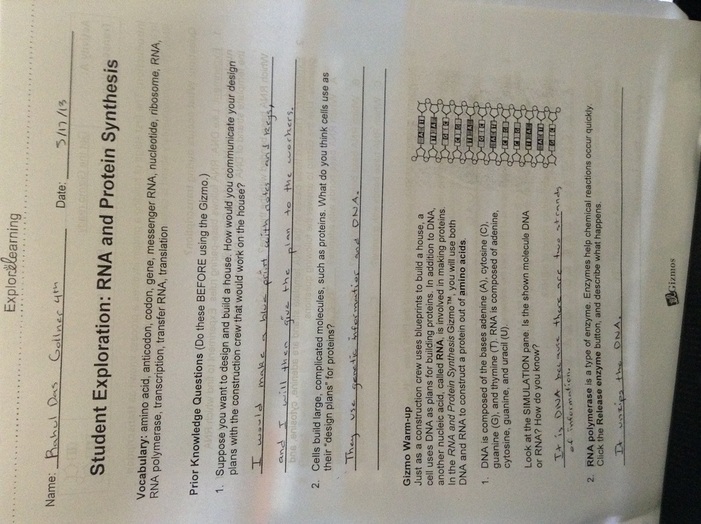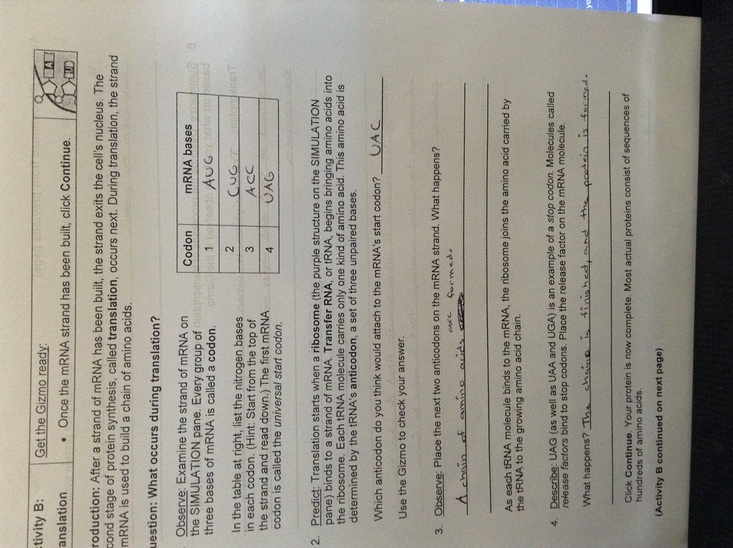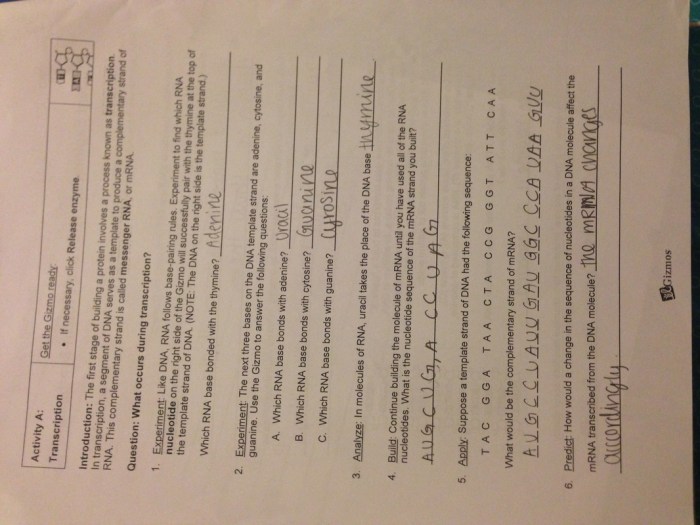Gizmo student exploration rna and protein synthesis – Embark on an enlightening journey with Gizmo Student Exploration: RNA and Protein Synthesis, where the complexities of gene expression unfold before your eyes. This interactive simulation empowers you to delve into the molecular machinery that orchestrates the synthesis of proteins, the workhorses of life.
Through a captivating interface and intuitive tools, Gizmo Student Exploration guides you through the intricate steps of RNA and protein synthesis, unraveling the secrets of genetic information flow.
1. Gizmo Student Exploration
RNA and Protein Synthesis

The Gizmo Student Exploration: RNA and Protein Synthesis is an interactive simulation that allows students to explore the processes of transcription and translation. The Gizmo provides a virtual environment where students can manipulate variables and observe the effects on protein synthesis.
The objectives of the Gizmo Student Exploration are to:
- Understand the structure and function of RNA.
- Describe the processes of transcription and translation.
- Identify the role of codons and anticodons in protein synthesis.
- Analyze the results of the Gizmo simulation.
The Gizmo Student Exploration interface includes a variety of tools that allow students to control the simulation. These tools include:
- A DNA sequence editor
- A transcription and translation engine
- A data analysis tool
To complete the Gizmo Student Exploration, students will follow these steps:
- Enter a DNA sequence into the DNA sequence editor.
- Click the “Transcribe” button to transcribe the DNA sequence into mRNA.
- Click the “Translate” button to translate the mRNA sequence into a protein.
- Analyze the results of the simulation using the data analysis tool.
2. Key Concepts in RNA and Protein Synthesis: Gizmo Student Exploration Rna And Protein Synthesis

RNA and its Different Types
RNA is a type of nucleic acid that is essential for protein synthesis. There are three main types of RNA: mRNA, tRNA, and rRNA.
- mRNA (messenger RNA)carries the genetic information from DNA to the ribosome, where it is used to direct protein synthesis.
- tRNA (transfer RNA)brings amino acids to the ribosome in the correct order, as specified by the mRNA sequence.
- rRNA (ribosomal RNA)is a component of ribosomes, the structures that assemble proteins.
Transcription, Gizmo student exploration rna and protein synthesis
Transcription is the process of copying the genetic information from DNA into mRNA. Transcription occurs in the nucleus of the cell and is carried out by an enzyme called RNA polymerase.
Translation
Translation is the process of converting the genetic information in mRNA into a protein. Translation occurs in the cytoplasm of the cell and is carried out by ribosomes.
Codons and Anticodons
Codons are three-nucleotide sequences in mRNA that specify which amino acid will be added to the growing protein chain. Anticodons are three-nucleotide sequences in tRNA that are complementary to codons. When a codon and an anticodon match, the tRNA brings the correct amino acid to the ribosome.
3. The Gizmo Simulation
Modeling Protein Synthesis

The Gizmo simulation models the process of protein synthesis by allowing students to manipulate the following variables:
- The DNA sequence
- The rate of transcription
- The rate of translation
The Gizmo simulation also generates data and graphs that can be used to analyze the results of the simulation. These data and graphs include:
- The sequence of the mRNA molecule
- The sequence of the protein molecule
- The rate of protein synthesis
4. Analyzing Results and Applications

The results of the Gizmo simulation can be analyzed to determine the effects of different variables on protein synthesis. For example, students can investigate the effects of the following variables on the rate of protein synthesis:
- The length of the DNA sequence
- The GC content of the DNA sequence
- The rate of transcription
- The rate of translation
The Gizmo simulation can also be used to investigate the effects of mutations on protein synthesis. For example, students can investigate the effects of the following mutations on the rate of protein synthesis:
- Point mutations
- Insertions
- Deletions
The Gizmo simulation is a valuable tool for understanding the processes of transcription and translation. The simulation can be used to investigate the effects of different variables on protein synthesis and to explore the effects of mutations on protein synthesis.
Detailed FAQs
What is the purpose of Gizmo Student Exploration: RNA and Protein Synthesis?
Gizmo Student Exploration: RNA and Protein Synthesis is designed to provide an interactive and engaging platform for students to explore the processes of RNA and protein synthesis, enhancing their understanding of gene expression.
What are the key concepts covered in the simulation?
The simulation covers key concepts such as the structure and function of RNA, the processes of transcription and translation, the role of ribosomes, and the importance of codons and anticodons in protein synthesis.
How can I use the simulation to analyze results?
The simulation generates data and graphs that can be analyzed to understand the effects of different variables on protein synthesis. This allows students to explore the impact of factors such as mutation, codon usage, and ribosome concentration.